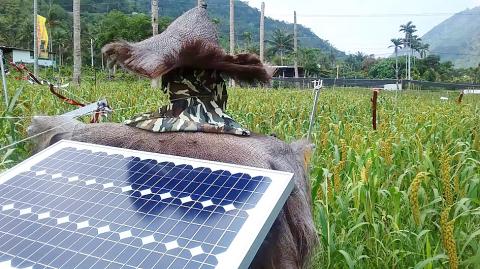Rice farmers in Taitung County have begun using scarecrows equipped with solar panels to protect crops from birds after researchers devised the technique as a labor-saving measure.
Researchers at the Taitung District Agricultural Research and Extension Station said the solar-powered scarecrows can make noises that scare away birds without harming the animals.
Farmers normally scare birds off with cans strung together by thread or with firecrackers, but this requires them to wake early and stay out late into the night until the birds leave their fields.

Photo: Chen Hsien-yi, Taipei Times
One farmer surnamed Pa (巴) said he and other farmers had tried different methods of scaring birds away, adding that all of the methods they tried required constant supervision of their fields.
Even with fields being supervised it was common to lose half of a year’s harvest to birds, he said.
Station technical specialist Tseng Hsiang-en (曾祥恩) said the scarecrows are more effective than farmers at scaring birds, because several of them can be used simultaneously to cover a field.
The NT$45,000 scarecrows are cheaper than human labor in the long term, Tseng said, adding that a network of scarecrows can be set up easily.
Station director Chen Yu-chu (陳昱初) said the station hopes the scarecrows would give farmers a way to protect their crops.
“One scarecrow can cover 1 hectare of land and can run for several years using ‘renewable’ energy. The other options available are expensive and quickly break down,” Chen said.

Beijing could eventually see a full amphibious invasion of Taiwan as the only "prudent" way to bring about unification, the US Department of Defense said in a newly released annual report to Congress. The Pentagon's "Annual Report to Congress: Military and Security Developments Involving the People's Republic of China 2025," was in many ways similar to last year’s report but reorganized the analysis of the options China has to take over Taiwan. Generally, according to the report, Chinese leaders view the People's Liberation Army's (PLA) capabilities for a Taiwan campaign as improving, but they remain uncertain about its readiness to successfully seize

Taiwan is getting a day off on Christmas for the first time in 25 years. The change comes after opposition parties passed a law earlier this year to add or restore five public holidays, including Constitution Day, which falls on today, Dec. 25. The day marks the 1947 adoption of the constitution of the Republic of China, as the government in Taipei is formally known. Back then the Chinese Nationalist Party (KMT) governed China from Nanjing. When the KMT, now an opposition party in Taiwan, passed the legislation on holidays, it said that they would help “commemorate the history of national development.” That

Trips for more than 100,000 international and domestic air travelers could be disrupted as China launches a military exercise around Taiwan today, Taiwan’s Civil Aviation Administration (CAA) said yesterday. The exercise could affect nearly 900 flights scheduled to enter the Taipei Flight Information Region (FIR) during the exercise window, it added. A notice issued by the Chinese Civil Aviation Administration showed there would be seven temporary zones around the Taiwan Strait which would be used for live-fire exercises, lasting from 8am to 6pm today. All aircraft are prohibited from entering during exercise, it says. Taipei FIR has 14 international air routes and

The Ministry of National Defense (MND) today released images of the military tracking China’s People's Liberation Army (PLA) movements during the latest round of Chinese drills around Taiwan. The PLA began "Justice Mission 2025" drills today, carrying out live-fire drills, simulated strikes on land and maritime targets, and exercises to blockade the nation's main ports. The exercises are to continue tomorrow, with the PLA announcing sea and air space restrictions for five zones around Taiwan for 10 hours starting from 8:30am. The ministry today released images showing a Chinese J-16 fighter jet tracked by a F-16V Block 20 jet and the